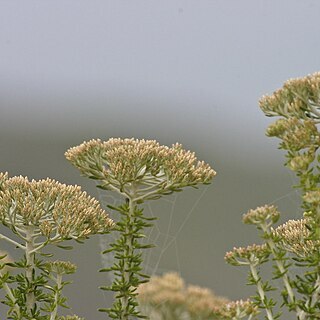Shrub, up to 2.5(-4.0) m high. Leaves straight, with brachyblasts less than half the length of subtending leaves, (0.9-)2.0-16.0 mm long, acute or acuminate, usually about half-twisted. Synflorescenses 10-90 mm wide, dense, usually distinctly branched, with capitula arranged in clusters. Capitula 3(4)-or 5-flowered, free from one another; involucre 1.5-3.0 mm wide; involucral bracts in 6-8(9) series, most bracts not petaloid, obtuse and slightly apiculate, apically erect, outermost brownish, rarely reddish or light pink, those inwards white. Flowering time Mar.-Sept. Pappus of apically flat and slightly serrate bristles, acute to obtuse. Cypselae narrowly oblong, 1.5-2.1 mm long, with short acute papillae.
Shrub, up to 2.5(-4.0) m high; erect. Leaves alternate, sessile; blade linear to very narrowly obovate, up to 16 x 3 mm, apex acute to acuminate, usually ± half-twisted, margins involute, glabrous or sometimes whitish tomentose on upper surface, with axillary brachyblasts. Heads discoid, 3-5-flowered, sessile or shortly pedunculate, arranged in clusters. Involucral bracts 6-8(9)-seriate, 1.5-3.0 mm wide, most not petaloid, obtuse and slightly apiculate, apically erect; outermost brownish, rarely reddish or light pink, hairy; inner bracts white, glabrous or glabrescent. Flowers: disc florets only, pink?; Sep.-Nov., Mar.-Jun. Fruit with cypsela narrowly oblong, brown. Pappus of serrate to dentate bristles.
Erect shrub, up to 2.5 m high, rarely 3-4-m. Leaves straight with axillary brachyblasts. Heads 3-5-flowered. Involucres narrow, brownish below with white innermost involucral bracts. Outer to inner involucral bracts with apiculate tips. Flowers with outer involucral bracts brownish, rarely reddish or light pink, inner white, rarely creamy white or dark brown to dark reddish; petaloid involucral bracts white to whitish.
Erect shrub, up to 2.5(-4) m tall, young branches whitish-woolly. Leaves often reflexed, twisted, linear to ovate, 2-15 mm long, with axillary tufts. Flowerheads discoid, several in often branched, terminal clusters, 10-90 mm diam., 3-5-flowered; involucral bracts erect or rarely spreading, outer brown below, inner petaloid, white sometimes brown.
Erect white-woolly shrub to 2.5(-4.0) m. Leaves often reflexed, lanceolate to ovate, twisted, 2-15 mm long, with axillary tufts. Flower heads discoid, several in terminal clusters, 3-5-flowered, bracts erect or rarely spreading, outer brown below, inner petaloid, white sometimes brown.
A shrub. It grows 2-3 m tall. The young branches have white hairs. The leaves are often twisted. They are 2-15 mm long. The flower heads have 3-5 flowers.

